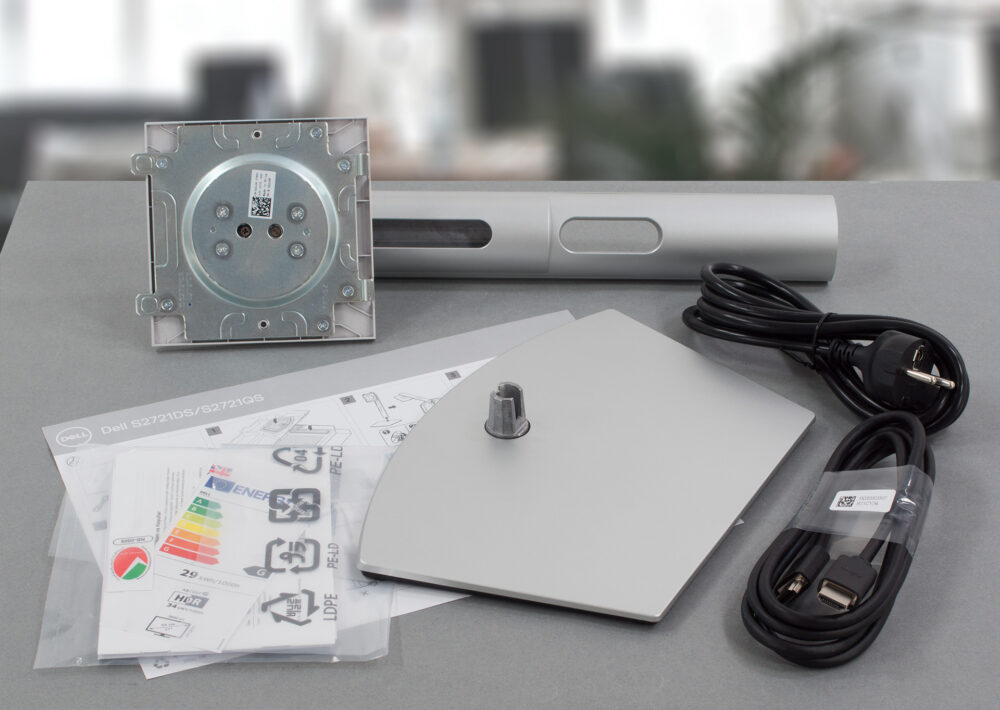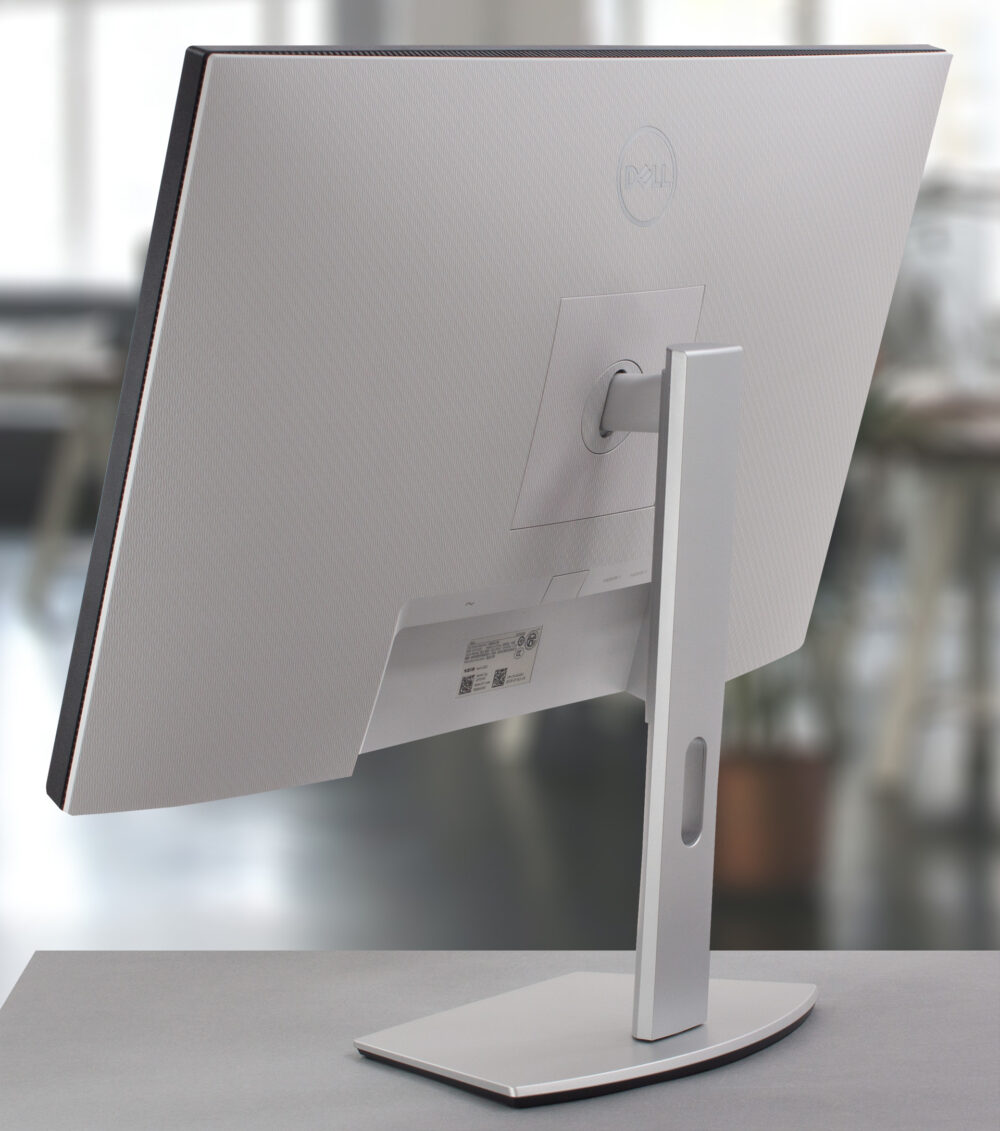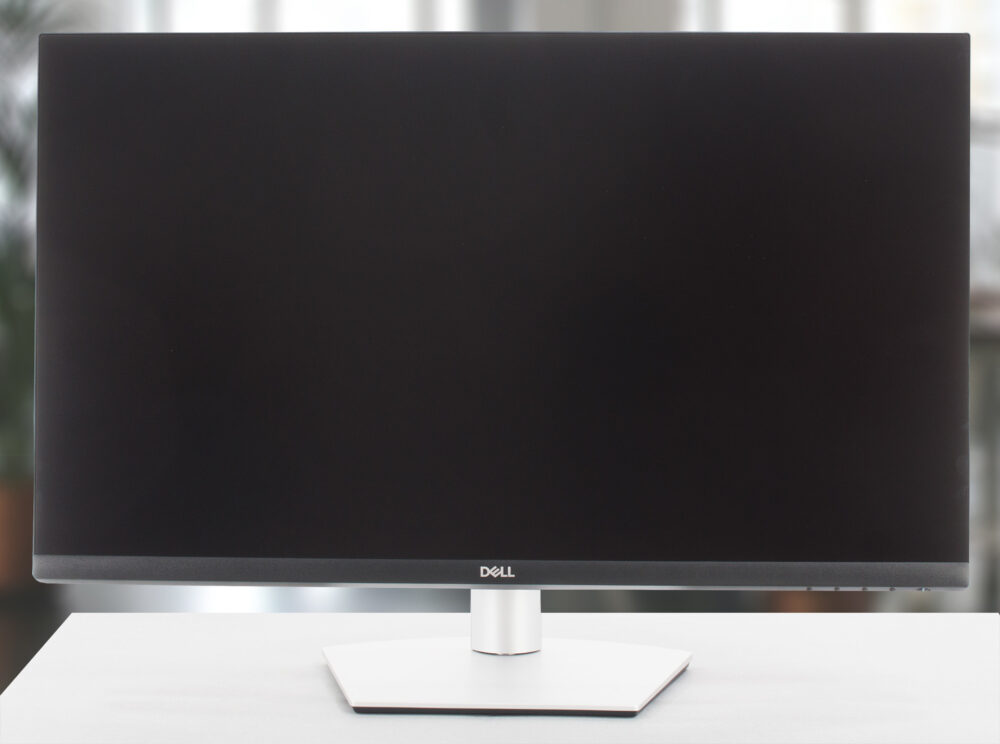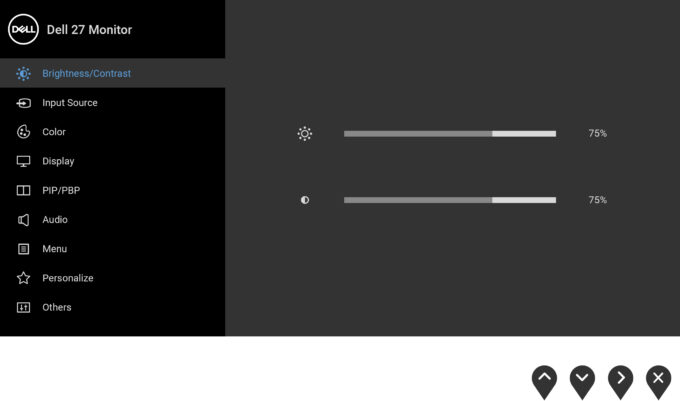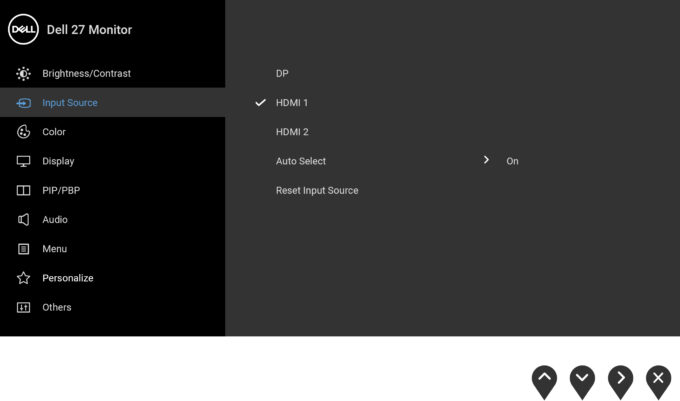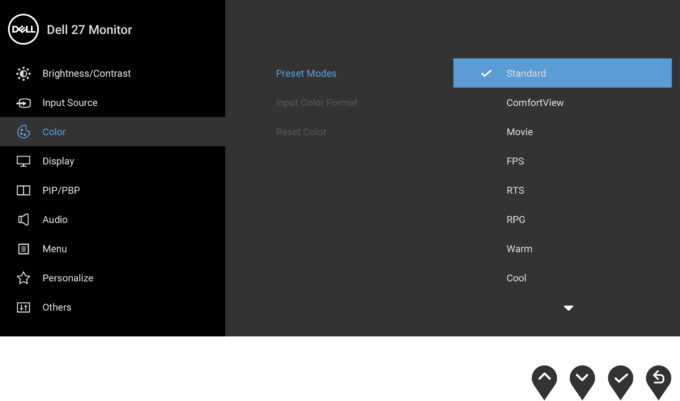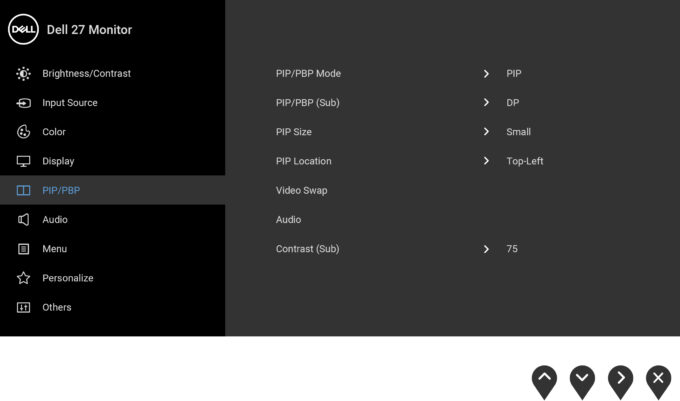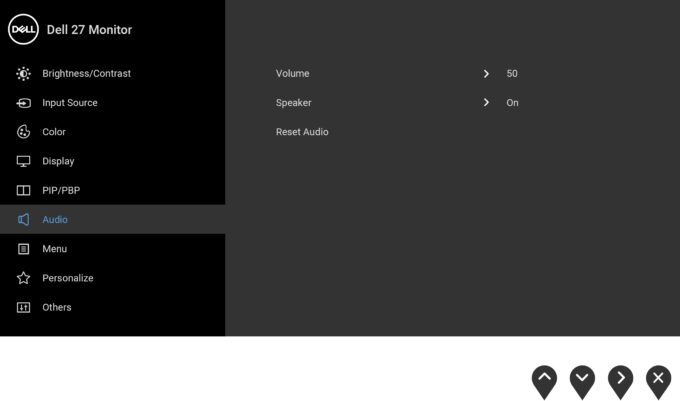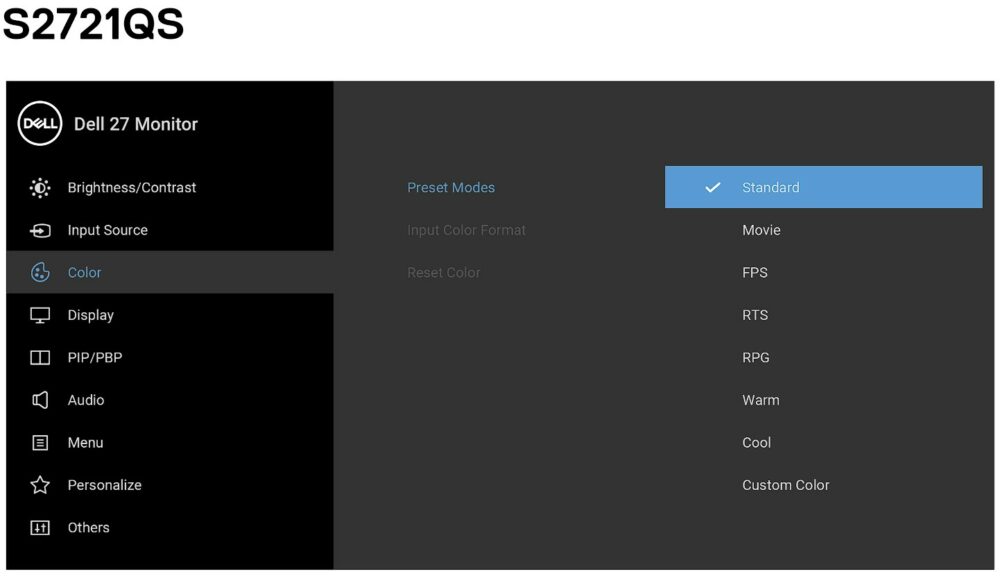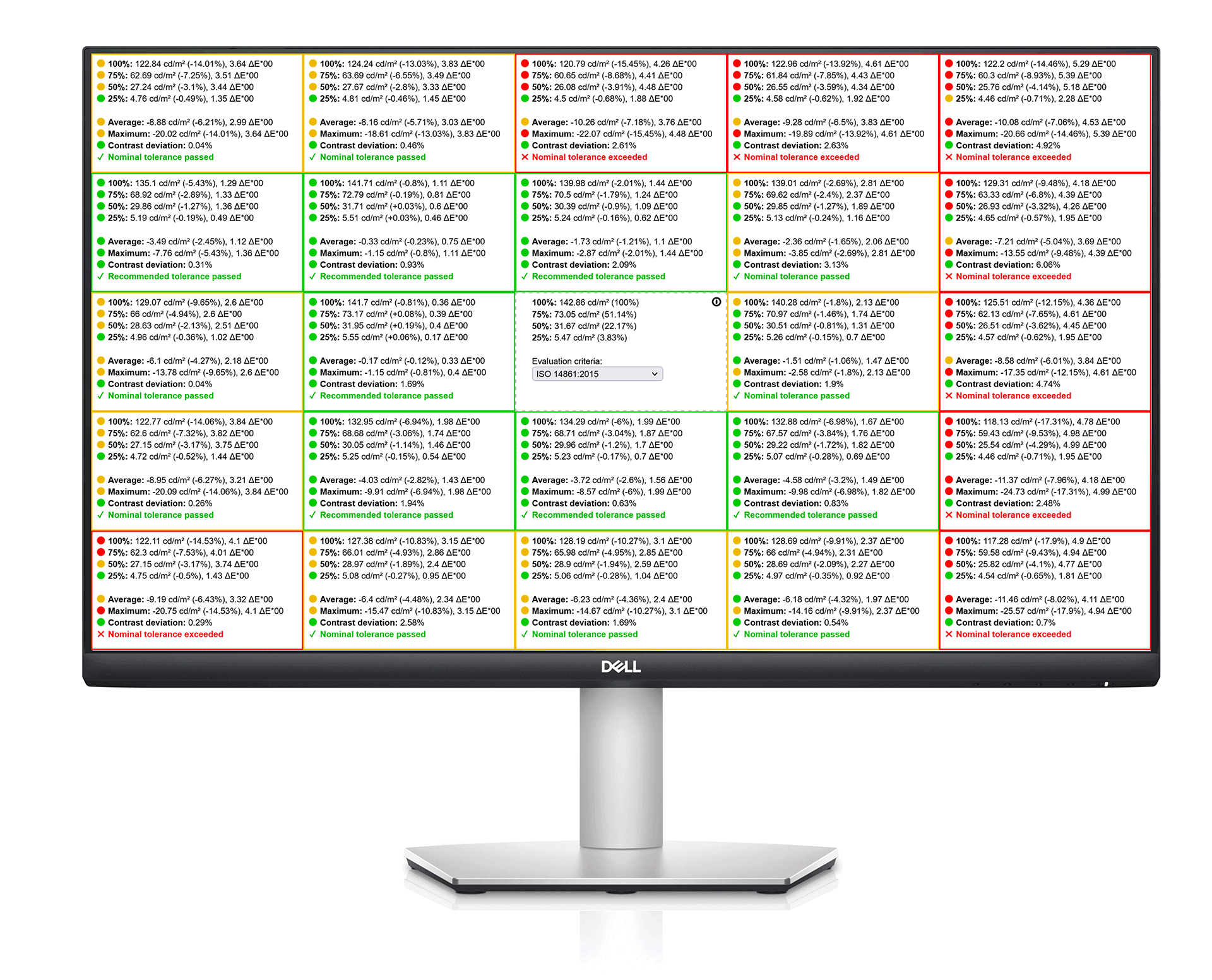 It is 2022, and UHD monitors are now more accessible than ever before. We still remember the time when 1080p entered the clutches of the computing market, and all of us considered it a super sharp solution, even on large scale. However, it feels like it’s been forever the golden standard nowadays, and we are finally coming to a turning point where laptops and monitors are been offered with 1440p and 4K panels as standard.
It is 2022, and UHD monitors are now more accessible than ever before. We still remember the time when 1080p entered the clutches of the computing market, and all of us considered it a super sharp solution, even on large scale. However, it feels like it’s been forever the golden standard nowadays, and we are finally coming to a turning point where laptops and monitors are been offered with 1440p and 4K panels as standard.
Today, we are going to show you what to expect when you purchase the Dell S2721QS, and if getting this device is actually worth it in the first place. Of course, not all 4K monitors are made the same, but what sets Dell units apart is the versatility and high quality of their stand.
Regarding the image quality of this particular unit, Dell states that it covers 99% of the sRGB color gamut. Furthermore, it comes with FreeSync, as well as two 3W stereo speakers.
You can check the current price of Dell S2721QS here: Buy from Amazon.com.au (#CommissionsEarned)
Contents
Unboxing and setup
As usual, the packaging includes the disassembled stand, a power cord, an HDMI connector, some regulatory paperwork, as well as a quick setup guide. It is pretty easy to assemble the device – just follow the three-step instructions, and be careful not to damage your new monitor.
Design and construction
If we have to place a purely subjective opinion here, we really like the dual-color design of this monitor. It makes the device stand out while keeping its looks classy. We also like the interesting pattern on the back.
Looking at the front though is where we can observe Dell’s achievements in trimming most of the space around the panel. The top and side bezels are almost nonexistent, while the bottom one is clearly bigger. In the bottom right corner, below the bezel, you will find the OSD menu controls.
And what would a Dell monitor review be if we don’t spare a moment to talk about its stand? It offers every motion imaginable, which makes it a great attribution to any office. Wall mounting is also possible, but you will have to find your own mounting hardware.
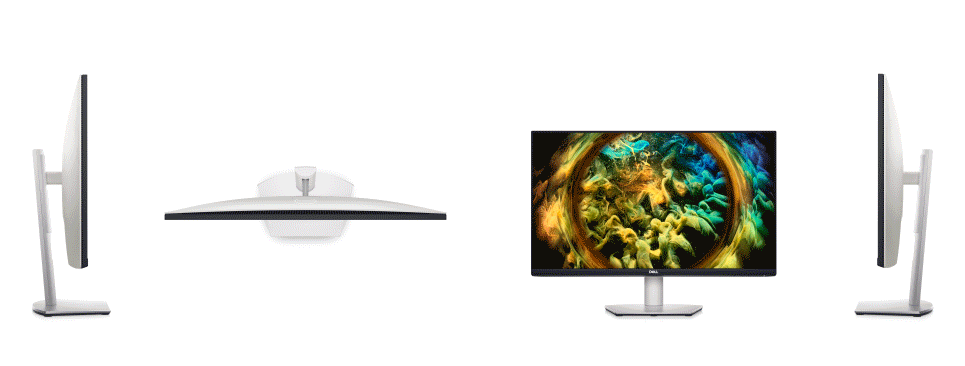
Ports
All of the ports are located on the back. There, you will find the power cord plug, two HDMI 2.0 connectors, a DisplayPort 1.2, and an audio jack.
OSD menu
Once you get into the OSD menu, you will see 8 subdivisions, as well as the monitor name and model in the top left corner (of the menu), and the current input port and resolution in the bottom left.
Inside the options, you can find the brightness adjustment, color preset adjustment, sharpness and response time, and more. By the way, the response time option refers to the Overdrive – more on that later.
Display quality
Dell S2721QS is equipped with an IPS-type panel. Its diagonal is 27″ (69 cm), has a resolution of 3840 x 2160 pixels, and a maximum refresh rate of 60Hz. The screen ratio is 16:9, and we are looking at a pixel density of – 163 ppi, and a pitch of 0.16 х 0.16 mm. The screen turns into Retina when viewed at distance equal to or greater than 53cm (31.5″) (from this distance one’s eye stops differentiating the separate pixels).

It has comfortable viewing angles. We offer images at 45° to evaluate image quality.

Also, a video with locked focus and exposure.
We measured a maximum brightness of 397 nits in the middle of the screen (“Custom color” – RGB R100, G100, B100 after Reset). The Correlated Color Temperature on a white screen and maximum brightness is 6570K, which is almost matching the sRGB standard of 6500K.
In the illustration below you can see how the display performs from a uniformity perspective. It is how matters are for operational brightness levels (approximately 140 nits) – in this particular case at 25% Brightness (White level = 143 cd/m2, Black level = 0.13 cd/m2).
Values of dE2000 over 4.0 should not occur, and this parameter is one of the first you should check if you intend to use the monitor for color-sensitive work. The contrast ratio is good – 1060:1.
All tests are made with the monitor connected to an NVIDIA GeForce RTX 2060.
To make sure we are on the same page, we would like to give you a little introduction to the sRGB color gamut and the Adobe RGB. To start, there’s the CIE 1976 Uniform Chromaticity Diagram that represents the visible specter of colors by the human eye, giving you a better perception of the color gamut coverage and the color accuracy.
Inside the black triangle, you will see the standard color gamut (sRGB) that is being used by millions of people on HDTV and on the web. As for the Adobe RGB, this is used in professional cameras, monitors, etc for printing. Basically, colors inside the black triangle are used by everyone and this is the essential part of the color quality and color accuracy of a mainstream display.
Still, we’ve included other color spaces like the famous DCI-P3 standard used by movie studios, as well as the digital UHD Rec.2020 standard. Rec.2020, however, is still a thing of the future and it’s difficult for today’s displays to cover that well. We’ve also included the so-called Michael Pointer gamut, or Pointer’s gamut, which represents the colors that naturally occur around us every day.
The yellow dotted line shows Dell S2721QS’s color gamut coverage in the “sRGB” mode in the first graphic and in “Standard” mode in the second.
This display covers 98% of the sRGB/ITU-R BT.709 (web/HDTV standard) in CIE1976.

Our “Design and Gaming” profile delivers optimal color temperature (6500K) at 140 cd/m2 luminance and sRGB encoding curve. We’ve used the “Color temperature User Mode – RGB R100, G94, B100” preset, and compared it to the “sRGB Mode” preset.
We tested the accuracy of the display with 24 commonly used colors like light and dark human skin, blue sky, green grass, orange, etc. You can check out the results at factory condition and also, with the “Design and Gaming” profile.
Below you can compare the scores of Dell S2721QS with the default settings (left), and with the “Gaming and Web design” profile (right). The comparison is made with the “Standard” preset.
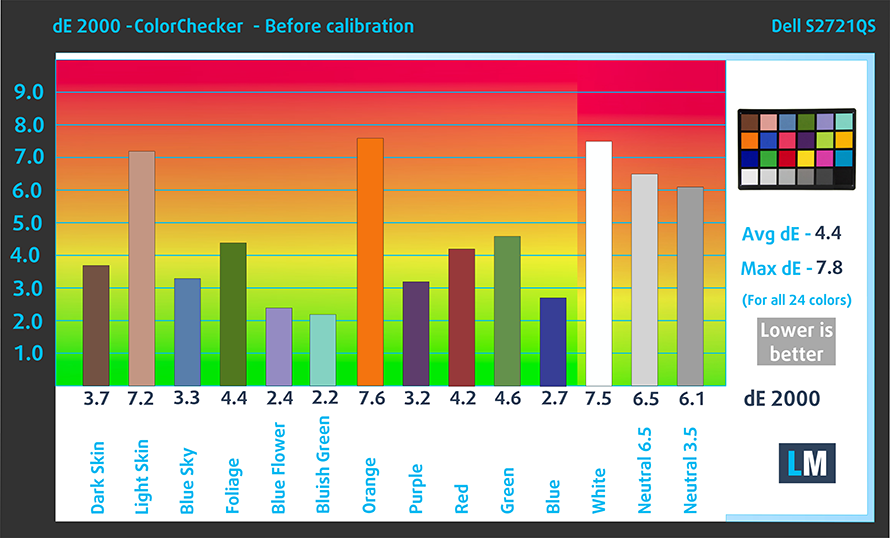
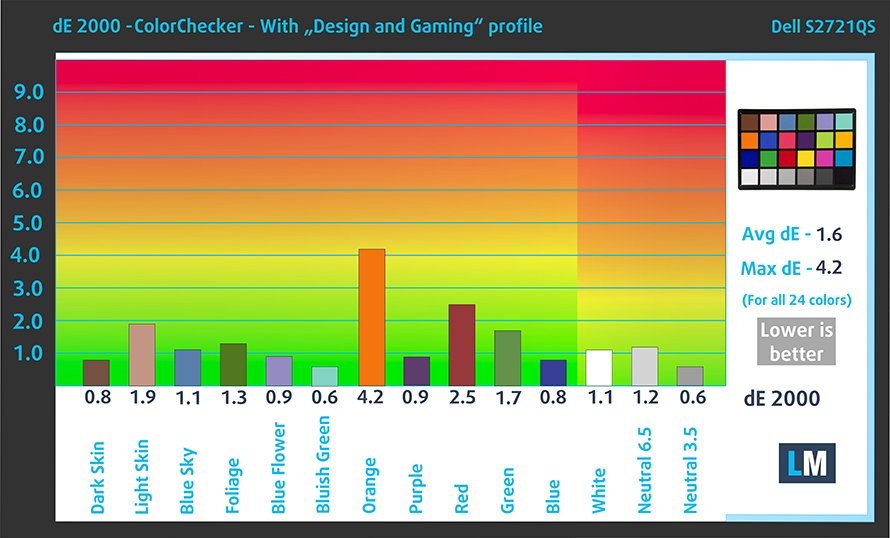
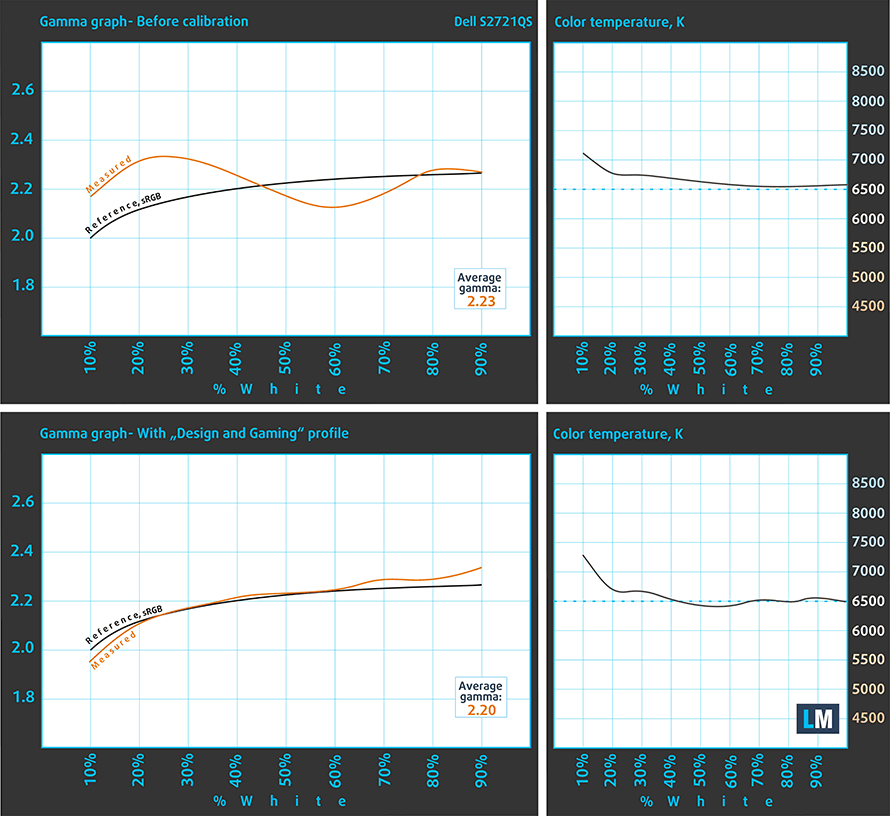
The next figure shows how well the display is able to reproduce really dark parts of an image, which is essential when watching movies or playing games in low ambient light.
The left side of the image represents the display with stock settings, while the right one is with the “Gaming and Web Design” profile activated. On the horizontal axis, you will find the grayscale, and on the vertical axis – the luminance of the display. On the two graphs below you can easily check for yourself how your display handles the darkest nuances but keep in mind that this also depends on the settings of your current display, the calibration, the viewing angle, and the surrounding light conditions.

Response time (Gaming capabilities)
The response time of the pixels shouldn’t be slower than the refresh cycle of the screen (16.67 ms for 60Hz, 6.94 ms for 144Hz, and so on). Ultimately, this results in ghosting, caused by the pixel’s inability to change in that amount of time, thus continuing in the next frame. In order to battle that issue, manufacturers use Overdrive. Essentially, this is a technique for RTC (Response Time Compensation). What does it do? Well, it supplies higher voltage to the crystals (in LCD monitors), which makes them switch their position faster. However, excessive levels of Overdrive can result in Overshooting, which transforms into inverse ghosting, coronas, and artifacts, obviously affecting the image quality in a negative way. This is why many manufacturers provide several levels of Overdrive, so you can choose which suits you best.
We test the reaction time of the pixels with the usual “black-to-white” and “white-to-black” method from 10% to 90% and vice versa and maximum brightness.
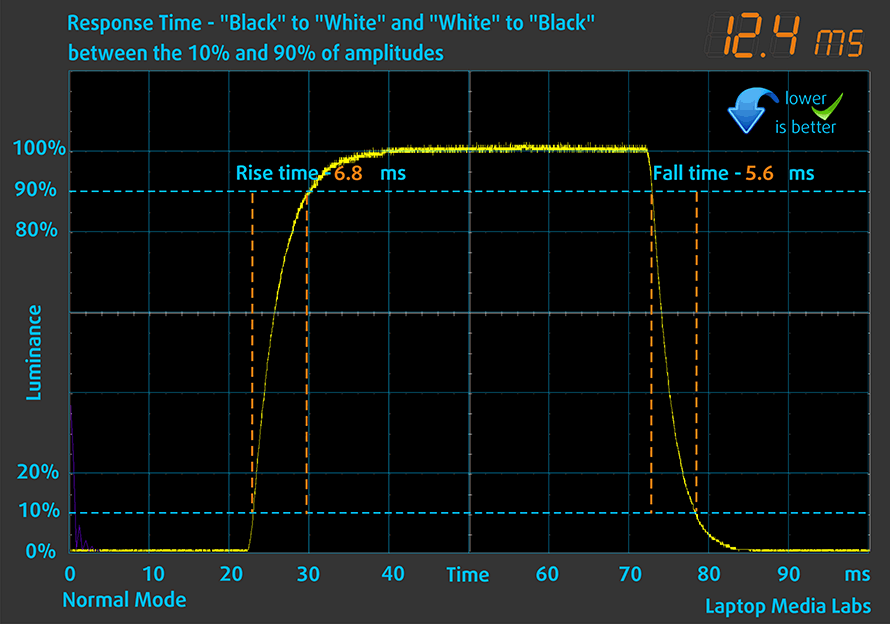
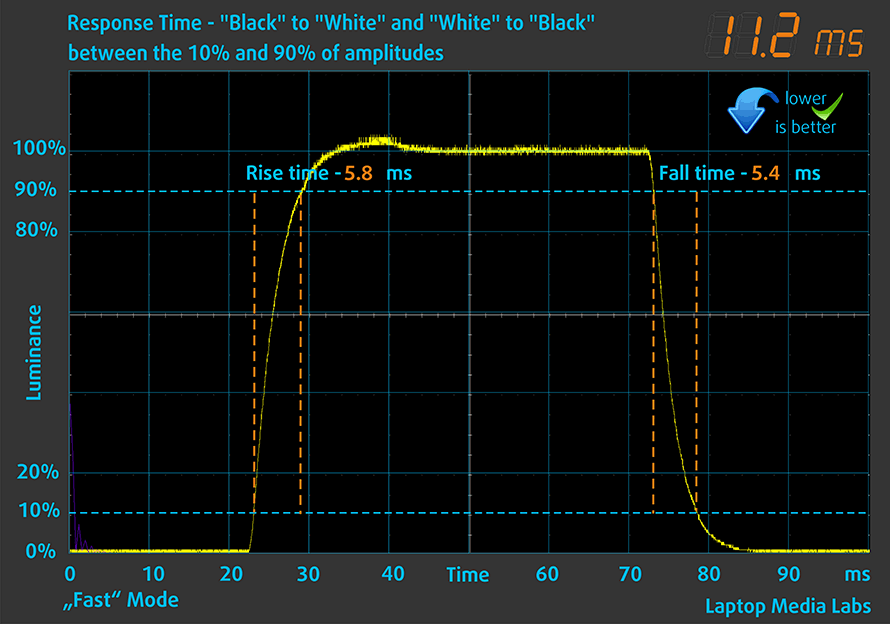
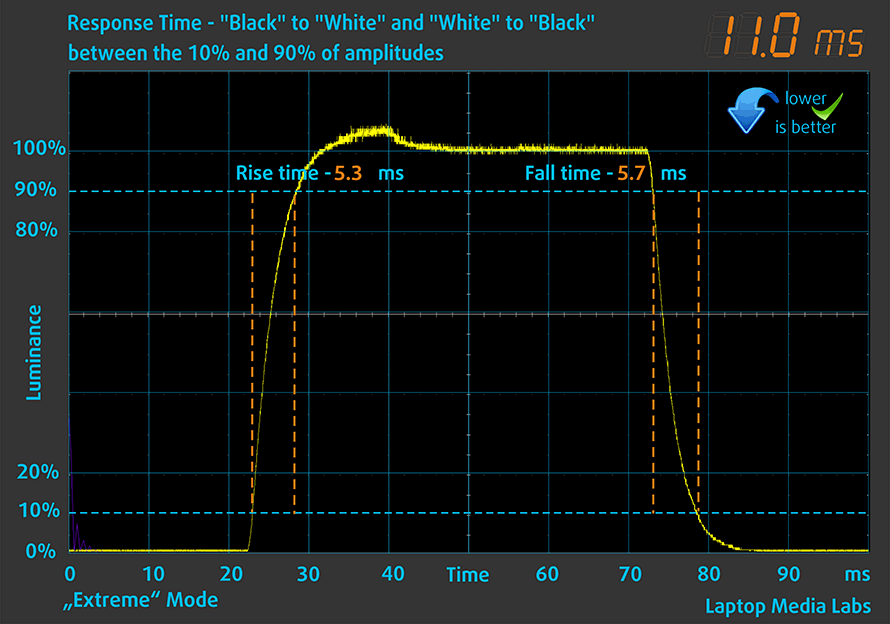
We test the reaction time of the pixels with the usual “Gray-to-Gray” method from 50% White to 80% White and vice versa between 10% and 90% of the amplitude and maximum brightness.

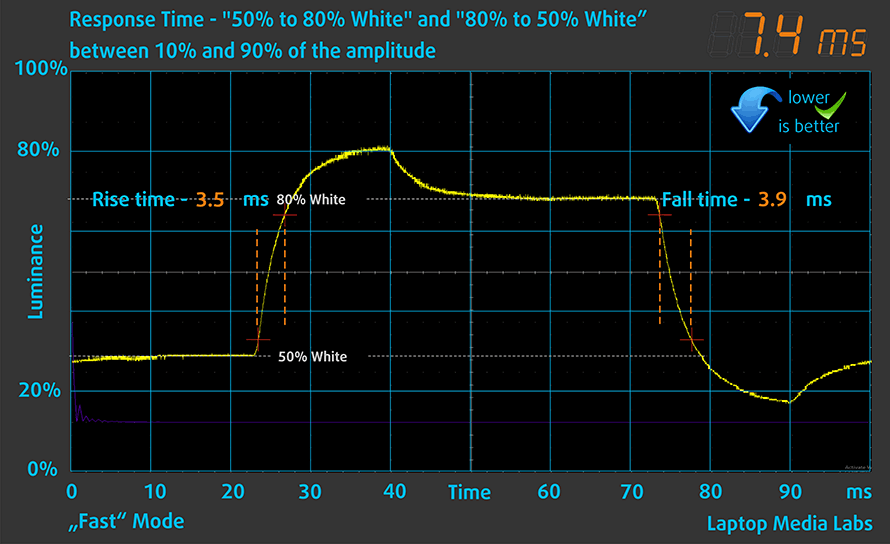
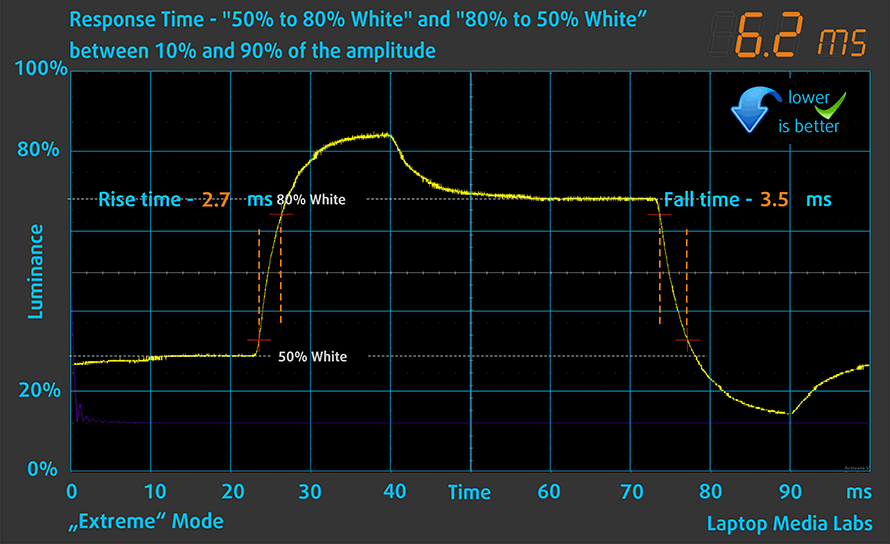
PWM (Screen flickering)
Pulse-width modulation (PWM) is an easy way to control monitor brightness. When you lower the brightness, the light intensity of the backlight is not lowered, but instead turned off and on by the electronics with a frequency indistinguishable to the human eye. In these light impulses, the light/no-light time ratio varies, while brightness remains unchanged, which is harmful to your eyes. You can read more about that in our dedicated article on PWM.
Dell S2721QS’s backlight is not PW-modulated at any brightness level. This makes it comfortable for your eyes in this aspect even during long working periods. (the results are with “OverClocking” enabled).
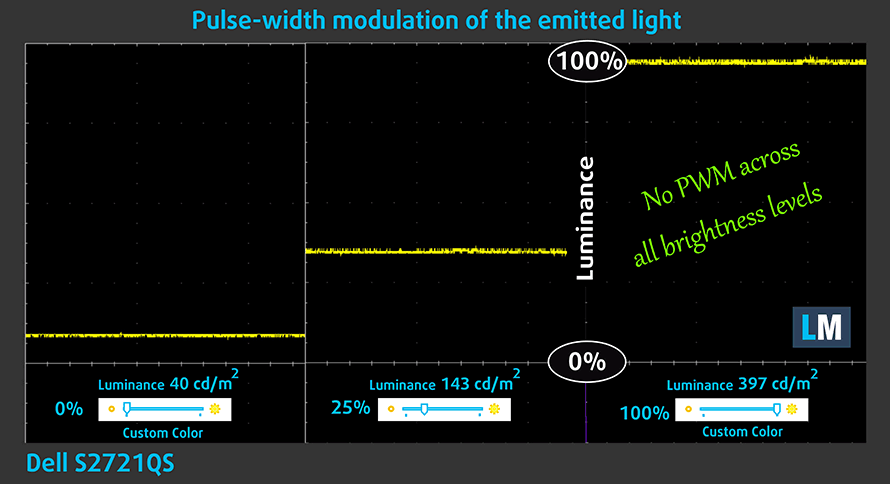
Blue light emissions
Installing our Health-Guard profile not only eliminates PWM but also reduces the harmful Blue Light emissions while keeping the colors of the screen perceptually accurate. If you’re not familiar with the Blue light, the TL;DR version is – emissions that negatively affect your eyes, skin, and your whole body. You can find more information about that in our dedicated article on Blue Light.
Gloss level measurement
Glossy-coated displays are sometimes inconvenient in high ambient light conditions. We show the level of reflection on the screen for the respective laptop when the display is turned off and the measurement angle is 60° (in this case, the measurements show a value of 53.4 GU, which is okay).
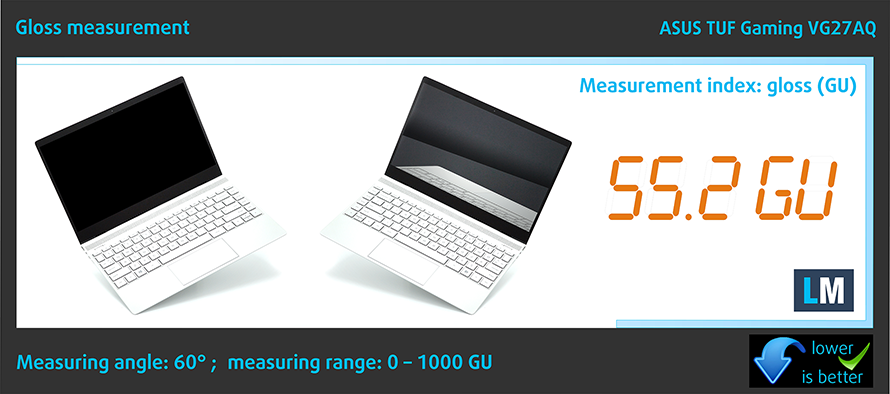
Buy our profiles
Since our profiles are tailored for each individual display model, this article and its respective profile package are meant for the Dell S2721QS.
In this case, the profiles are ready for work after a factory reset, except for the Gaming and Web design profile, where you need to set the display to the “sRGB mode”. Interestingly, depending on the ambient light and the game you’re playing it is highly possible that the Office Work profile might be more appealing than the Gaming and Web design one.
*Should you have problems with downloading the purchased file, try using a different browser to open the link you’ll receive via e-mail. If the download target is a .php file instead of an archive, change the file extension to .zip or contact us at [email protected].
Read more about the profiles HERE.
In addition to receiving efficient and health-friendly profiles, by buying LaptopMedia's products you also support the development of our labs, where we test devices in order to produce the most objective reviews possible.

Office Work
Office Work should be used mostly by users who spend most of the time looking at pieces of text, tables or just surfing. This profile aims to deliver better distinctness and clarity by keeping a flat gamma curve (2.20), native color temperature and perceptually accurate colors.

Design and Gaming
This profile is aimed at designers who work with colors professionally, and for games and movies as well. Design and Gaming takes display panels to their limits, making them as accurate as possible in the sRGB IEC61966-2-1 standard for Web and HDTV, at white point D65.

Health-Guard
Health-Guard eliminates the harmful Pulse-Width Modulation (PWM) and reduces the negative Blue Light which affects our eyes and body. Since it’s custom tailored for every panel, it manages to keep the colors perceptually accurate. Health-Guard simulates paper so the pressure on the eyes is greatly reduced.
Get all 3 profiles with 33% discount
Verdict
 Dell S2721QS offers a really detailed image, due to its 4K resolution. In addition, it has a relatively quick pixel response time, good contrast ratio, comfortable viewing angles, and a pretty high maximum brightness. Furthermore, its backlight doesn’t use PWM for brightness adjustment, which means you are safe to use it for as long as you need, without suffering the negative effects of flickering.
Dell S2721QS offers a really detailed image, due to its 4K resolution. In addition, it has a relatively quick pixel response time, good contrast ratio, comfortable viewing angles, and a pretty high maximum brightness. Furthermore, its backlight doesn’t use PWM for brightness adjustment, which means you are safe to use it for as long as you need, without suffering the negative effects of flickering.
As promised, it covers the sRGB color gamut almost fully. By default, the color accuracy could have been better. However, with a lot of time dedicated to calibrating and profiling the panel, we were able to bring its Average dE to a value of under 2.0. This makes it appropriate for professional use.
Architects and civil engineers, for example, would be really happy to work with it. An even better use case would be to get two of these panels and pair them together. The slim bezels will allow a pretty immersive experience, while the evergreen stand can help you turn the monitor to 90°.
Indeed, this is not a gaming panel, but you can definitely play games on it, thanks to the fast pixel response time and FreeSync support. And if you want something more closely dedicated to gaming, you can check out our Alienware AW2521H review – it has a 360Hz refresh rate, which is bonkers!
You can check the current price of Dell S2721QS here: Buy from Amazon.com.au (#CommissionsEarned)
Pros
- The optimal size for desktop computing
- 4K resolution, resulting in a crisp image
- Well-populated OSD menu
- Adjustable height, tilt, swivel, and pivot
- Complete sRGB color gamut coverage and standard-matching dE values (thanks to our profiles)
- Reasonable price tag
Cons
- Limited I/O

